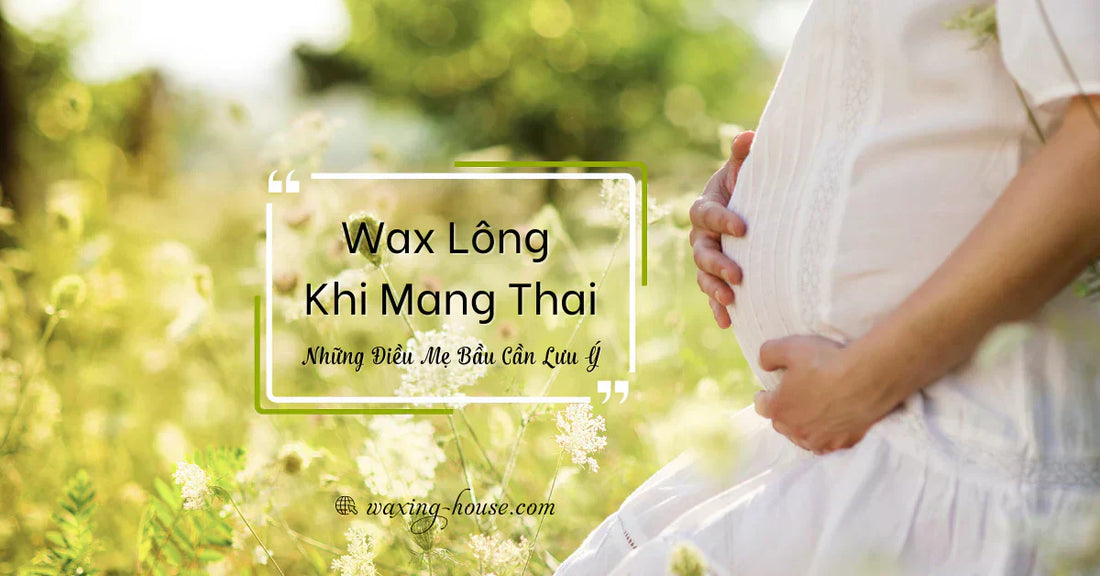
Waxing While Pregnant: What You Need to Know
Share
Waxing While Pregnant: What You Need to Know
Pregnancy is a wonderful journey, but it also comes with countless bodily changes, especially increased and thicker hair growth. One of the most common questions is: "Can pregnant women get waxed?".
The answer is yes, waxing during pregnancy is generally considered safe, but it requires preparation and important considerations to ensure a comfortable and safe experience for both mother and baby.
This article will answer everything an expectant mother needs to know, from common questions to the appropriate waxing process at a spa.
Quick Answers to Common Questions
1. Should pregnant women get waxed?
Yes. Pregnant women can still get waxed if their health is stable. However, it's advisable to choose a reputable salon with experienced technicians to ensure safety.
2. Does waxing during pregnancy affect the fetus?
No. Waxing only affects the surface of the skin and does not harm the baby. However, expectant mothers should avoid waxing if they experience severe morning sickness, vaginal bleeding, or have a history of premature birth.
3. Is waxing more painful during pregnancy?
Yes, it is likely to be more painful. During pregnancy, hormonal changes increase blood flow to the skin, making it more sensitive, prone to irritation, and more susceptible to pain. This is why the sensation of waxing might feel different than before.
4. Is it okay to get a bikini wax while pregnant?
Yes, but with caution. A bikini wax during pregnancy can help with hygiene and comfort during childbirth. It should be performed at a professional spa with technicians trained in waxing for pregnant women.
5. What type of wax is suitable for pregnant women?
It's best to choose a hard wax with gentle, fragrance-free ingredients or natural extracts. Specialized products like Jax Wax Banksia or Bluebell are ideal for sensitive skin.
6. What should expectant mothers use to moisturize their skin after waxing?
After waxing, you should use soothing, non-irritating products without artificial fragrances. Prioritize specialized after-wax products for sensitive skin to help it recover quickly. (Suggestion: Jax Wax Bluebell after-wax lotion imported from Australia)
Benefits of Waxing During Pregnancy and Before Childbirth
Many expectant mothers choose to get a bikini wax in the final months of pregnancy for these practical benefits:
-
Hygiene: Removing hair from the underarms and bikini area helps expectant mothers maintain personal hygiene more easily, feeling more confident and comfortable during check-ups and childbirth.
-
Confidence and Comfort: Thicker hair growth during this time can be uncomfortable for many expectant mothers; waxing helps 'moms' feel more confident.
-
Hair grows back softer: Hair that regrows after waxing is usually softer and not as coarse or uncomfortable as after shaving.
-
The optimal choice: Waxing is the optimal method for removing unwanted hair during this time, as other methods (shaving, depilatory creams, laser hair removal) are often not feasible.
6 Tips for a Safe Waxing Experience for Pregnant Women
For a safe waxing session, expectant mothers should keep the following in mind:
Consult your doctor
Before deciding to wax, especially during the early or late stages of pregnancy or if you have a history of skin issues, consult your obstetrician.
Choose a reputable salon
A professional waxing salon will have clean hygiene practices, high-quality products, products specifically for sensitive skin, and skilled technicians who know how to perform waxing on pregnant women as gently as possible.
Always inform the technician
Let the technician know how many weeks pregnant you are and if you have any history of allergies to cosmetics or waxing. This helps them choose the right products, adjust their technique, and assist you in the most comfortable positions.
Ideal time to wax
The second trimester (from week 13 to 28) is often the ideal time to wax, as the body is more stable and the belly is not yet too large.
Check your skin's condition
Ensure the area you plan to wax is completely healthy, with no open wounds, scratches, sunburn, or any signs of inflammation.
Understand the safe bikini wax process
A standard procedure will include cleansing, using suitable wax, proper waxing technique, removing residual wax, and applying aftercare products to ensure maximum safety and comfort.
When to Avoid Waxing
Although waxing is safe for most expectant mothers, you should postpone your hair removal session if you fall into any of the following categories:
- The intended waxing area is damaged, inflamed, has warts, varicose veins, or a rash.
- You have a history of miscarriage or premature birth (consult your doctor).
- You have a history of allergies to cosmetics or wax.
- You are using medications or topical products containing Retinoids, AHA, or BHA.
Aftercare for Pregnant Women
Skin is even more sensitive after waxing during pregnancy and needs extra care. Follow these guidelines:
- Wear loose-fitting, breathable cotton clothing.
- Avoid hot baths, saunas, and swimming for 24-48 hours.
- Use gentle, fragrance-free moisturizers recommended for pregnant women or specialized after-wax products.
Conclusion: Waxing during pregnancy is not only safe but also offers a lot of convenience. As long as you choose the right place and prepare carefully, you can enjoy smooth skin and confidence throughout your pregnancy.
The information in this document is for reference purposes only and does not substitute for medical diagnosis or advice. Please consult a doctor before applying any care methods to ensure they are appropriate for your individual health condition.
